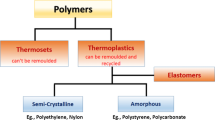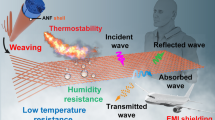Abstract
A bismuth oxide (Bi2O3)-dispersed carboxylated nitrile butadiene rubber (XNBR) flexible film was prepared as a flexible lead-free material for gamma ray (γ-ray) attenuation. However, obtaining a uniform and stable dispersion of Bi2O3 in carboxylated nitrile butadiene rubber latex (XNBRL) is a challenge due to sedimentation induced by the remarkable density differences. Here, this challenge was approached by reducing the Bi2O3 particle radius, increasing the viscosity of the latex, and adding a dispersant. The experimental results confirmed that Bi2O3 was well dispersed in the XNBRL in the concentration range of 30–70 wt%. The mechanical properties demonstrated that the Bi2O3/XNBR flexible films had a good resistance to oil, acid, alkali, and hot air. The linear attenuation coefficients of the Bi2O3/XNBR flexible films obtained from the experiments were in good agreement with the calculated values. The attenuation efficiencies of the Bi2O3/XNBR flexible films with different thicknesses and Bi2O3 contents were investigated for a few different γ-ray energies. These results showed that the Bi2O3/XNBR flexible films have wide application prospects for low-energy γ-ray attenuation.












Similar content being viewed by others
References
S. Fu, Y. Sun, Y. Lu, Current status of radiation therapy for prostate cancer. Nucl. Sci. Tech. 18, 65–72 (2007). https://doi.org/10.1016/S1001-8042(07)60021-9
Q. Liu, B. Jiang, L.P. Jiang et al., Clinical report of three cases of acute radiation sickness from a 60Co radiation accident in Henan province in China. J. Radiat. Res. 49, 63–69 (2008). https://doi.org/10.1269/jrr.07071
S. Zhao, S. Huang, S. Liu et al., Measurements of 134Cs and 137Cs in urine and estimation of the internal dose of an adult exposed to the Chernobyl Accident. Nucl. Sci. Tech. 18, 115–117 (2007). https://doi.org/10.1016/S1001-8042(07)60030-X
I. Akkurt, H. Akyıldırım, B. Mavi et al., Photon attenuation coefficients of concrete includes barite in different rate. Ann. Nucl. Energy 37, 910–914 (2010). https://doi.org/10.1016/j.anucene.2010.04.001
M.E. Medhat, Y. Wang, Investigation on radiation shielding parameters of oxide dispersion strengthened steels used in high temperature nuclear reactor applications. Ann. Nucl. Energy 80, 365–370 (2015). https://doi.org/10.1016/j.anucene.2015.01.044
M.H. Kharita, M. Takeyeddin, M. Alnassar et al., Development of special radiation shielding concretes using natural local materials and evaluation of their shielding characteristics. Prog. Nucl. Energy 50, 33–36 (2008). https://doi.org/10.1016/j.pnucene.2007.10.004
N. Singh, K.J. Singh, K. Singh et al., Comparative study of lead borate and bismuth lead borate glass systems as gamma-radiation shielding materials. Nucl. Instrum. Methods Phys. Res., Sect. B 225, 305–309 (2004). https://doi.org/10.1016/j.nimb.2004.05.016
J. Kim, D. Seo, B.C. Lee et al., Nano-W dispersed gamma radiation shielding materials. Adv. Eng. Mater. 16, 1083–1089 (2014). https://doi.org/10.1002/adem.201400127
W. Qin, D. Peng, X. Wu, Study on the damage effects of electron and proton combined irradiation on T700/cyanate composites. Nucl. Instrum. Methods Phys. Res., Sect. B 312, 126–130 (2013). https://doi.org/10.1016/j.nimb.2013.07.017
J.P. Mccaffrey, H. Shen, B. Downton et al., Radiation attenuation by lead and nonlead materials used in radiation shielding garments. Med. Phys. 34, 530–537 (2007). https://doi.org/10.1118/1.2426404
D.N.A. Dodoo-Amoo, S. Landsberger, J.M. MacDonald et al., Development of composite materials for non-leaded gloves for use in radiological hand protection. Health Phys. 84, 737–746 (2003). https://doi.org/10.1097/00004032-200306000-00006
M.E. Cournoyer, G.L. George, R.L. Dodge et al. Replacement of lead-loaded glovebox glove with attenuation medium that are not RCRA-hazardous metals. 2010, 17th Pacific Basin Nuclear Conference Cancun mexico
H. Chai, X.B. Tang, M.X. Ni et al., Preparation and properties of novel, flexible, lead-free X-ray-shielding materials containing tungsten and bismuth(III) oxide. J. Appl. Polym. Sci. 133, 43012–43018 (2016). https://doi.org/10.1002/app.43012
M. Mirzaei Aliabadi, G. Naderi, S.J. Shahtaheri et al., Transport properties of carboxylated nitrile butadiene rubber (XNBR)-nanoclay composites; a promising material for protective gloves in occupational exposures. J. Environ. Health Sci. Eng. 12, 51–58 (2014). https://doi.org/10.1186/2052-336x-12-51
M.A. Misman, A.R. Azura, Z.A.A. Hamid, The physical and degradation properties of starch-graft-acrylonitrile/carboxylated nitrile butadiene rubber latex films. Carbohydr. Polym. 128, 1–10 (2015). https://doi.org/10.1016/j.carbpol.2015.04.004
K.P. Nair, A.B. Nair, R. Joseph, Carboxylated acrylo nitrile butadiene rubber latex/kaolin nanocomposites: preparation and properties. Compos. Interfaces 21, 571–583 (2014). https://doi.org/10.1080/15685543.2014.899198
G. Marković, M.S. Marinović-Cincović, V. Jovanović et al., Gamma irradiation aging of NBR/CSM rubber nanocomposites. Compos. B Eng. 43, 609–615 (2012). https://doi.org/10.1016/j.compositesb.2011.11.056
S.E. Gwaily, M. Madani, H.H. Hassan, Lead—Natural rubber composites as gamma radiation shields. II: high concentration. Polym. Compos. 23, 495–499 (2002). https://doi.org/10.1002/pc.10450
S.A.M. Issa, A.M.A. Mostafa, Effect of Bi2O3 in borate-tellurite-silicate glass system for development of gamma-rays shielding materials. J. Alloys Compd. 695, 302–310 (2017). https://doi.org/10.1016/j.jallcom.2016.10.207
W. Hao, Y. Gao, X. Jing et al., Visible light photocatalytic properties of metastable γ-Bi2O3 with different morphologies. J. Mater. Sci. Technol. 30, 192–196 (2014). https://doi.org/10.1016/j.jmst.2013.09.023
B.A. Benetskii, M.V. Plotnikova, Gamma-radiation accumulation factors for composite materials and radiation shields. Bull. Lebedev. Phys. Inst. 39, 113–117 (2012). https://doi.org/10.3103/S1068335612040045
V.P. Singh, S.P. Shirmardi, M.E. Medhat et al., Determination of mass attenuation coefficient for some polymers using Monte Carlo simulation. Vacuum 119, 284–288 (2015). https://doi.org/10.1016/j.vacuum.2015.06.006
S. Hariharan, R. Udayabhaskar, T.R. Ravindran et al., Surfactant assisted control on optical, fluorescence and phonon lifetime in α-Bi2O3 microrods. Spectrochim. Acta, Part A 163, 13–19 (2016). https://doi.org/10.1016/j.saa.2016.02.045
S. Chakraborty, I. Sarkar, D.K. Behera et al., Experimental investigation on the effect of dispersant addition on thermal and rheological characteristics of TiO2 nanofluid. Powder Technol. 307, 10–24 (2017). https://doi.org/10.1016/j.powtec.2016.11.016
P.C. Hiemenz, R. Rajagopalan, Principles of Colloid and Surface Chemistry (Marcel Dekker, New York, 1997)
Z.N. Ain, A.R. Azura, Effect of different types of filler and filler loadings on the properties of carboxylated acrylonitrile–butadiene rubber latex films. J. Appl. Polym. Sci. 119, 2815–2823 (2011). https://doi.org/10.1002/app.32984
M.R. Ambika, N. Nagaiah, V. Harish et al., Preparation and characterisation of Isophthalic-Bi2O3 polymer composite gamma radiation shields. Radiat. Phys. Chem. 130, 351–358 (2017). https://doi.org/10.1016/j.radphyschem.2016.09.022
R. Sharma, M. Khanuja, S.N. Sharma et al., Reduced band gap & charge recombination rate in Se doped α-Bi2O3 leads to enhanced photoelectrochemical and photocatalytic performance: theoretical & experimental insight. Int. J. Hydrog. Energy 42, 20638–20648 (2017). https://doi.org/10.1016/j.ijhydene.2017.07.011
L. Wang, W. Wang, Y. Fu et al., Enhanced electrical and mechanical properties of rubber/graphene film through layer-by-layer electrostatic assembly. Compos. Part B Eng. 90, 457–464 (2016). https://doi.org/10.1016/j.compositesb.2015.12.048
X. He, T. Li, Z. Shi et al., Thermal-oxidative aging behavior of nitrile-butadiene rubber/functional LDHs composites. Polym. Degrad. Stab. 133, 219–226 (2016). https://doi.org/10.1016/j.polymdegradstab.2016.08.018
A. Laskowska, M. Zaborski, G. Boiteux et al., Effects of unmodified layered double hydroxides MgAl-LDHs with various structures on the properties of filled carboxylated acrylonitrile–butadiene rubber XNBR. Eur. Polym. J. 60, 172–185 (2014). https://doi.org/10.1016/j.eurpolymj.2014.09.013
R.L. Sala, T.M. Arantes, E. Longo et al., Evaluation of modified silica nanoparticles in carboxylated nitrile rubber nanocomposites. Colloids Surf. A 462, 45–51 (2014). https://doi.org/10.1016/j.colsurfa.2014.08.012
Y. Han, L.X. Mao, H.W. Meng et al., Novel self-crosslinking film from hydrogenated carboxylated nitrile rubber latex. J. Appl. Polym. Sci. 131, 39865–39871 (2014). https://doi.org/10.1002/app.39865
G. Janowska, A. Kucharska-Jastrzabek, A. Kasiczak et al., Thermal properties and combustibility of cross-linked XNBR/CSM blends. J. Therm. Anal. Calorim. 104, 1107–1115 (2011). https://doi.org/10.1007/s10973-011-1328-9
T. Biswas, D.K. Basu, Cure synergism in XNBR vulcanization in presence of thiophosphoryl disulfides and amine disulfide/thiazole accelerators. J. Appl. Polym. Sci. 60, 1349–1359 (1996). https://doi.org/10.1002/(sici)1097-4628(19960531)60:9<1349::aid-app10>3.0.co;2-y
W. Qin, D. Peng, X. Wu et al., Study on the resistance performance of TiO2/cyanate ester nano-composites exposed to electron radiation. Nucl. Instrum. Methods Phys. Res., Sect. B 325, 115–119 (2014). https://doi.org/10.1016/j.nimb.2014.01.022
I. Akkurt, A.M. El-Khayatt, The effect of barite proportion on neutron and gamma-ray shielding. Ann. Nucl. Energy 51, 5–9 (2013). https://doi.org/10.1016/j.anucene.2012.08.026
S.A.M. Issa, Effective atomic number and mass attenuation coefficient of PbO–BaO–B2O3 glass system. Radiat. Phys. Chem. 120, 33–37 (2016). https://doi.org/10.1016/j.radphyschem.2015.11.025
K. Kirdsiri, J. Kaewkhao, N. Chanthima et al., Comparative study of silicate glasses containing Bi2O3, PbO and BaO: radiation shielding and optical properties. Ann. Nucl. Energy 38, 1438–1441 (2011). https://doi.org/10.1016/j.anucene.2011.01.031
S.M. Vahabi, M. Bahreinipour, M.S. Zafarghandi, Determining the mass attenuation coefficients for some polymers using MCNP code: a comparison study. Vacuum 136, 73–76 (2017). https://doi.org/10.1016/j.vacuum.2016.11.011
Author information
Authors and Affiliations
Corresponding authors
Additional information
This work was supported by the National Natural Science Foundation of China (No. 11405149) and the Military Technology Extension Project (No. JMZF201601).
Rights and permissions
About this article
Cite this article
Liao, YC., Xu, DG. & Zhang, PC. Preparation and characterization of Bi2O3/XNBR flexible films for attenuating gamma rays. NUCL SCI TECH 29, 99 (2018). https://doi.org/10.1007/s41365-018-0436-7
Received:
Revised:
Accepted:
Published:
DOI: https://doi.org/10.1007/s41365-018-0436-7




